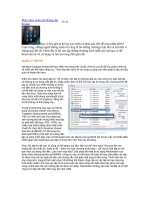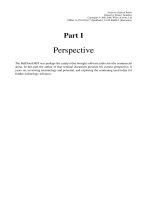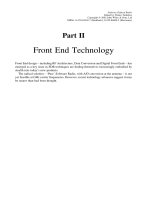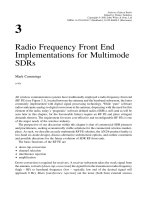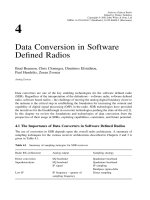tài liệu phần mềm siêu âm
Bạn đang xem bản rút gọn của tài liệu. Xem và tải ngay bản đầy đủ của tài liệu tại đây (1.57 MB, 14 trang )
<span class='text_page_counter'>(1)</span><div class='page_container' data-page=1>
<b>A</b>
<b>li</b>
<b>ti</b>
<b>f f</b>
<b>t</b>
<b>i</b>
<b>Application of fast scanning </b>
<b>technique “compressed SENSE” on </b>
<b>MR system Philips Ingenia 1.5T</b>
<i><b>Phan Anh Phuong;</b> Nguyễn Cơng tiến; Nguyễn Văn Hịa; </i>
<i>Lê Văn Tài; Trần Duy Hưng; Nguyễn Tuấn Dũng; Lê Xuân Thanh</i>
<i>Radiology center in Bach Mai hospital</i>
Advantages of MRI
• Powerful imaging modality for clinical
• Noninvasive examination of the body
• does not use ionizing radiation
• High soft‐tissue characterization with flexible image‐contrast
parameters
</div>
<span class='text_page_counter'>(2)</span><div class='page_container' data-page=2>
Disadvantages of MRI
• Has been relatively slow compared to other imaging modalities such
as CT
• Low speed, thus long examination times
• Limit spatial resolution and volumetric coverage
• sensitivity to respiratory motion
<b>The goals in MRI</b>
</div>
<span class='text_page_counter'>(3)</span><div class='page_container' data-page=3>
Compromises in MRI
The invention of fast MR Imaging
strategies
• Fast Low Angle Shot (FLASH)
• Fast Spin‐ Echo(FSE) Imaging
• Echo‐Plana Imaging
• Since Late 1990s Parallel Imaging techniques were proposed
</div>
<span class='text_page_counter'>(4)</span><div class='page_container' data-page=4>
Parallel Imaging
MRI questions.com
</div>
<span class='text_page_counter'>(5)</span><div class='page_container' data-page=5>
0
‐
20
times
JPEG VS RAW
1
0
The concept of compressed sensing, which was originally
proposed in the early 2000s by Donoho and Candès
K - space transform in MRI
</div>
<span class='text_page_counter'>(6)</span><div class='page_container' data-page=6>
Only centre and periphery of K - Space
<b>TF</b>
<b>TF</b>
</div>
<span class='text_page_counter'>(7)</span><div class='page_container' data-page=7>
Compressed
SENSE principle
The goal image Incoherent
subsampling
Wavelet transform
Denoising by threshold
Compressed SENSE principle
Wavelet
transform and
denoised
saparsity
Incoherent
undersampling
Non‐liner iterative
</div>
<span class='text_page_counter'>(8)</span><div class='page_container' data-page=8>
Philips Compressed SENSE
<i>(2D, 3D, 4D, all anatomies, all MRI sequences)</i>
=
=
SENSE
+
Compressed Sensing
<i>(2D, 3D, 4D, all anatomies) (3D, body area)</i>
Conventional sequences VS compressed SENSE
43%
400
600
800
T2_TSE_SAG
_0.8X0.8X4
mm_3.33S
T1_TSE_SA
G_0.8X0.8X
4mm_3.36S
CS_T2_TSE_SAG
_0.8X0.8X4mm
_2.02S
CS_T1SAG_T
SE_0.8X0.8X
4mm_2.00S
T2_AX_TSE_0.8X0.
8X4mm_3.36S
CS_T2_AX_TSE_0.8
X0.8X4mm_2.07S
10.45s 0 6.09s
200
400
</div>
<span class='text_page_counter'>(9)</span><div class='page_container' data-page=9>
CS_FLAIR_AX_FS_
0.69x1.1_RE1.3_2.58S
CS_T2_TSE_AX_
0.6x0.75_1.42S_RE 1.5 TOF_CS SENSE_0.6x0.9_RE3_2.59S
7.39s
0
200
400
600
800
TIME
NON_CS CS
32%
FLAIR AX_FS_0.69x1.1_3.50S T2_TSE_AX_0.6x0.75_2.31S TOF_SENSE_0.6x0.9_4.47S
11.08s
Application on Philips 1.5T Ingenia
</div>
<span class='text_page_counter'>(10)</span><div class='page_container' data-page=10>
Application on Philips 1.5T Ingenia
CS_T1 3D_TSE_FS Sag_1.1.1mm_3:18s(CS=5)
Application on Philips 1.5T Ingenia
</div>
<span class='text_page_counter'>(11)</span><div class='page_container' data-page=11>
`
Increase resolution
T2_SAG_TSE_1x
1.35x4mm_59S
CS_T2_SAG_TSE_0.8x0.8X4mm_
59S_RE 1.6_FOV280mm
</div>
<span class='text_page_counter'>(12)</span><div class='page_container' data-page=12>
Up to 50% acceleration
Acceleration for <b>all2D & 3D </b>anatomical contrasts, <b>100% coverage</b>on all anatomies
Body
Brain Spine MSK
Vascular
Cardiac Breast Whole body
compatible
• 2D and 3D sequences
• Fat saturation
• Dark fluid
• Dixon
• T1, T2, PD
</div>
<span class='text_page_counter'>(13)</span><div class='page_container' data-page=13>
Drawback
• Cannot be used:
• EPI
• Multislice‐TSE with partial NSA is used( half scan)
• Non‐Cartesian scans( multiVane )
• OMAR
• spectroscopy
</div>
<span class='text_page_counter'>(14)</span><div class='page_container' data-page=14>
Compressed SENSE- conclusion
• Faster imaging, higher system throughput
• Image quality improvement is possible
• Applicable in all anatomical regions
• Work with almost 2D, 3D sequences
• Easier for breath hold/ faster for dynamic imaging
• New high end study become possible
• New high‐end study become possible
</div>
<!--links-->
Tài liệu phần mềm thư viện
- 56
- 553
- 1




